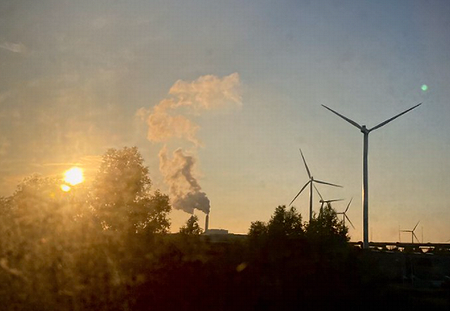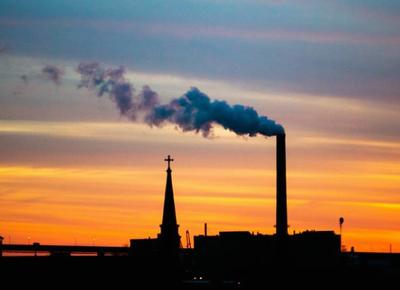
LONDON, UK, September 21, 2021 (ENS) – Targets set by 131 countries as they aim for net-zero carbon emissions could limit global climate change to temperatures close to Paris Agreement goals, finds new research from a team of European scientists.
The Paris Agreement, adopted by 196 countries in 2015, took effect the following year. It has the goal of limiting average global temperature increase to well below 2°Celsius higher than pre-industrial levels, while pursuing efforts to limit it to 1.5°C.
“The wave of net-zero targets by countries shows that they understand where our emissions need to land to halt global heating. However, they will only have an impact if they are also achieved,” said co-author Dr. Joeri Rogelj, director of research at the Grantham Institute, Imperial College London. He explores how societies can transform themselves towards more sustainable futures.
“Currently, the near-term pledges from countries do not yet carve out a path towards achieving their long-term net zero targets, and even under the most optimistic assumptions we still expect that we will exceed 1.5°C by a large margin,” Dr. Rogelj said. “More work and more ambitious targets are still necessary.”
The study is published today in the journal “Nature Climate Change” under the title, “Wave of net zero emission targets opens window to meeting the Paris Agreement.”
The primary way countries aim to achieve the 2°C goal is by setting net-zero targets. These are pledges to reduce their greenhouse gas emissions and balance the remainder with methods to remove these gases from the atmosphere.
At the time of the Paris Agreement, only a handful of countries had such pledges in place. Over the past five years, this number has increased rapidly, with major emitters like China and the United States recently making pledges to reach net-zero emissions.
In 2019, the United Kingdom pledged to be net zero by 2050, and now the Biden administration has followed suit. So far, 131 countries have announced net-zero pledges, covering 72 percent of global carbon emissions. But it is still not clear whether these are sufficient to prevent dangerous climate change.
Now, the new analysis has shown that if currently announced net-zero pledges are fully implemented, temperature rises could be limited to 2.0 to 2.4°C, bringing the Paris Agreement goal into the realm of the possible.
But the authors note that this requires pledges to be fully realized, with an emphasis on rapid cuts to emissions. While some pledges are ambitious, they are only promises until governments make plans and policies to ensure they happen.
Policies that are currently in place would still lead to average temperature rises of approximately 2.7-3.5°C, according to the study.
Dr. Rogelj said, “The wave of net-zero targets by countries shows that they understand where our emissions need to land to halt global heating. However, they will only have an impact if they are also achieved.”

The research team says countries must focus on rapidly reducing emissions before 2030 in order to reduce the amount of greenhouse gases they would need to remove from the atmosphere to achieve net zero by the year 2050. Currently, the authors say, few countries have detailed plans on how they will reach this goal.
The study concludes that long-term net-zero targets that have robust plans for reducing emissions by 2030 would reduce the uncertainty in temperatures beyond this year, and could limit heating to 1.9-2.0°C.
To make their estimates, the researchers used two models that estimate future emissions resulting from current net-zero pledges at country and global scales – the Climate Action Tracker and the UN Environment Program’s emissions gap report.
These two models differ slightly in the way they estimate the effects of current policies, but both show a consistent effect of net-zero pledges being carried out: a 0.8 to 0.9°C reduction in predicted temperature rises.
The researchers warn that existing policies and targets driving short-term action are currently not at all consistent with the announced net zero targets, and that good intentions must now translate into short-term action to put countries on a path towards meeting their net zero emission ambitions.
“Wave of net zero emission targets opens window to meeting the Paris Agreement” by Niklas Höhne, Matthew J. Gidden, Michel den Elzen, Frederic Hans, Claire Fyson, Andreas Geiges, M. Louise Jeffery, Sofia Gonzales-Zuñiga, Silke Mooldijk, William Hare and Joeri Rogelj is published in the journal “Nature Climate Change.”
The Research Team
Co-author Niklas Höhne is founder of the NewClimate Institute in Cologne, Germany and a professor at Wageningen University.
Co-authors Frederic Hans, Louise Jeffery, Sofia Gonzales-Zuñiga, and Silke Mooldijk are also climate policy analysts at NewClimate Institute.
Co-author physicist Dr. Bill Hare is the co-founder and CEO of Climate Analytics, an international non-profit climate science and policy institute based in Berlin, Germany, with offices in New York and Lomé, Togo.
Co-author Dr. Matthew Gidden, an American nuclear engineer, joined Climate Analytics as team leader for Mitigation Pathway Analysis in 2019.
Co-author Claire Fyson’s work bridges the climate policy and climate diplomacy teams at Climate Analytics. Co-author Andreas Geiges on the Climate Policy Team at Climate Analytics is involved in the Climate Action Tracker.
Michel den Elzen is senior climate policy analyst at the PBL Netherlands Environmental Assessment Agency, a Dutch research institute. He is a climate policy advisor to the EU delegation of the climate negotiations.
Dr. Joeri Rogelj serves as director of research at the Grantham Institute – Climate Change and the Environment at Imperial College London. In addition, he is a senior research scholar in the Energy, Climate, and Environment Program of the International Institute for Applied Systems Analysis.
Featured image: The 2.5 GW Bhadla Solar Park is spread out over 15 square miles of desert in the Jodhpur district of India’s Rajasthan stat. Currently the world’s largest wind park, Bhadla is just one small part of India’s ambitious plan to install 100 GW of solar by 2022. (Image courtesy Google and the French Space Agency Centre National d’Études Spatiales, CNES)



